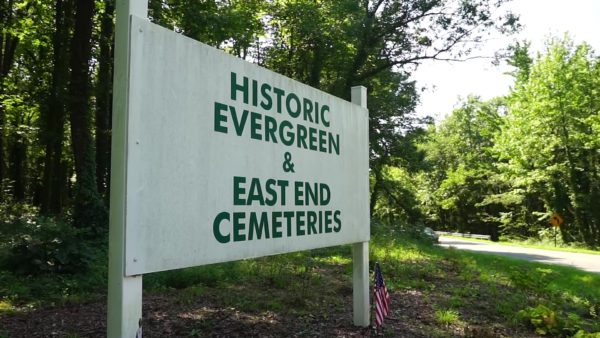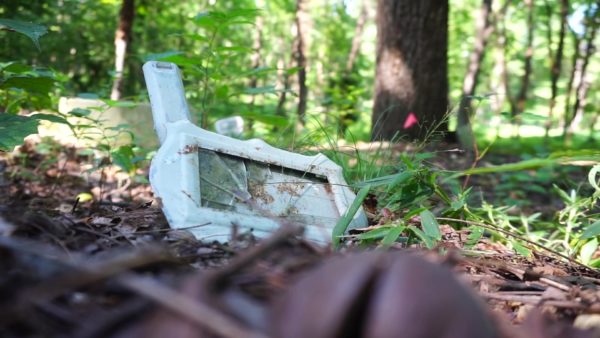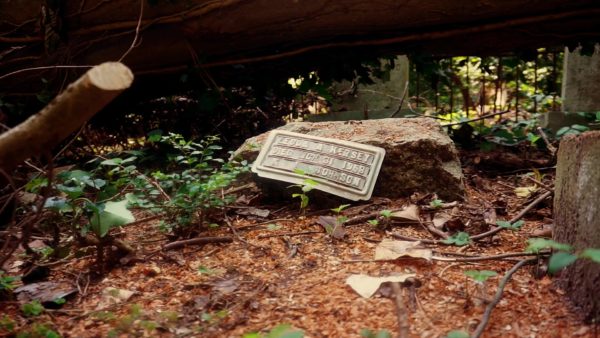The people laid to rest in these places experienced systematic prejudices and were never fully appreciated for the great impact they played in building this country. Then in death, their lives continue to be forgotten. In addition to resource inequality, legislative funding has also disproportionately supported the preservation and documentation of historical white cemeteries.
The stories are meant to shine a spotlight on how systemic racism affects even the dead.
In Virginia, Oakwood Cemetery in the state capital of Richmond is right beside the historic African-American Evergreen and East End cemeteries. Oakwood was established around the same time in the 19th century as the nearby Black cemeteries but was originally only for white people. The contrast in appearance and upkeep between Oakwood and Evergreen and East End is notable.
Until recently, it’s been up to the local African-American communities to first realize that those burial grounds are there, decide what to do with them, and then organize themselves to take care of them. Government funding to maintain African-American gravesites has been denied, but funding has flowed for Confederate graves from the same time period. Some remark on the contrast as another example of disproportionate care and funding.

“Please make no mistake about it — it wasn’t disproportionate,” exclaimed Rep. A. Donald McEachin, who represents Virginia’s 4th District in Congress. “They were the only ones getting funds. It’s not like there is anything for the Black folks or slave graves.”
According to McEachin, Confederate sites receive around $50 per grave, compared to Black graves that had no funding in the 1990s when he started his journey to help out.
Rep. McEachin co-sponsored a still-pending bill in 2019 that would place the care of a network of historic Black cemeteries underneath the umbrella of the National Parks Service. He claims there’s a stark contrast between most historically Black resting places compared to many historically white-occupied burial grounds.

Some observers feel these disparities in the care of the final resting places of Americans of different races reflect the continuation of the Jim Crow era of discrimination.
“Jim Crow is embedded into the landscape,” Brian Palmer exclaimed one Sunday morning as he walked through the overgrown paths of the two historic Black burial grounds. “Just because we had Rosa [Parks], Martin [Luther King Jr.], Fannie Lou [Hamer], and Malcolm [X], does not mean that we are liberated from the legacy of Jim Crow. That’s what we mean by systemic racism.”
Palmer has been a journalist and storyteller since the 1980s. He and his wife Erin left New York and moved to Virginia in 2013.
Shortly after Palmer decided to stay in Virginia, he and his wife became a couple of the founding members of a volunteer cleanup organization called Friends of East End, one of the major groups who’ve helped take care of the site along with others. At the end of 2019 Palmer also learned that somewhere on the grounds he has a relative, giving him an even deeper connection to the grounds.

In recent years, the Virginia Assembly has been working to attend to the neglected and overlooked historic Black cemeteries in the state.
Part of that is rich history where the past is laid to rest, like Evergreen and East End cemeteries — both of which passersby probably might never notice were there because of the system of luscious foliage stretching across the multi-acre resting places.
“You have people who were born enslaved,” said Palmer, “You have people who fought for this country when they were still less than full citizens.”

Evergreen was founded in 1892 and East End was founded in 1897. They are two separate cemeteries that began as one, both started by prominent African-Americans.
“You have a range of super prominent, wealthy people to regular folk,” Palmer said.
Based on the density of the gravesites in East End alone, it’s estimated that anywhere from 13,000 to 17,000 people buried on the 16-acre lot alone.
“It was 77 acres total and almost 80 percent or 90 percent of it had been lost to nature,” recalled John Sydnor, executive director of Enrichmond, the nonprofit that has current ownership of both cemeteries.
The organization was originally formed by the city as the Richmond Parks and Rec Foundation. In the past decade, it’s changed the name to Enrichmond and mainly serves as a more proactive approach to cultural, open space, and environmental preservation.
“The Entzmingers are an African American family who had started a business doing this. and right from the beginning they were running into racist issues, racial injustice that were trying,” Sydnor said as he recalled the land purchase. “It was very difficult for them to make money. Neglect is not the right word for what happened at East End and Evergreen, and I still to this day haven’t really come up with a good word for it.”

Sydnor claims that funds for historic Black graves have increased to about $5 per grave.
Like so many in the country, these cemeteries have for years been overgrown and under-tended. Still, some could say by the look of things, these are some of the more fortunate ones.
Since 2017, both cemeteries have received over $870,000, $85,0000 of which is used to cover costs that include maintenance, land management, historic preservation, and more according to Enrichmond. The majority of the money comes from the state government followed by a handful of foundations, corporate sponsorships, local and federal government, and individual contributions. The transition to the nonprofit’s administration does not please everyone.
“Of course, it’s an urban green space, but fundamentally it’s a cemetery — two cemeteries. so you don’t skip from the busted-up burial ground to yuppie party park,” said Palmer.
As the names on tombstones fade and the stories are lost, there are those who refuse to allow American history to be buried and forgotten.
“I think it’s crucial for us to recognize that Jim Crow may be embedded into the landscape, but over the decades, we have ripped apart — with fingers, with brains, with hands— the vestiges of Jim Crow, and we can do that here,” Palmer expressed as he pointed to the overgrown burial plots. “This tells us about who we are and if we want that power to fight all this, we’ve got the stories right here. We have power but we’ve got to take the lead.”
The East End and Evergreen Cemeteries in Richmond in Henrico Counties have been overlooked even by those in the community despite being some of the largest historic African-American burial sites in the country. Now, through legislation and community support, foundations are working to better preserve the historic sites and honor the people and their families. The Enrichmond Foundation is partnering with Howard Wellman Conservation to create a preservation plan. In recent years, Virginia has been working to attend to the neglect of the historic Black cemeteries. A guide is expected to be completed by the end of this month before being reviewed by the Historic Evergreen Cemetery Executive Planning and Review Team.
This story is first in the series “Below the Surface: The Fight to Protect African-American Cemeteries.” The series takes a look at the disparities and the ever-present systemic racism Black Americans face even in death.

